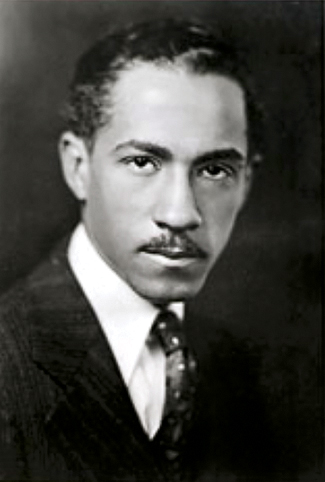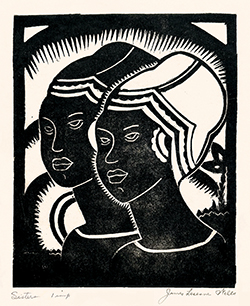
“Wells is more than an artist with a deep concern for his fellow man. He carries many of his themes a step further into an apocalyptic world, a world of revelation and shifting lights. … He works on large blocks in a bold free style. … His work has a vigor, therefore, that is not often used in the medium today.”
—Jacob Kainen (painter, critic, and collector) from Richard J. Powell’s 1986 essay Phoenix Ascending: The Art of James Lesesne Wells.
James Lesesne Wells was an American painter, printmaker, educator, and pioneering figure of the Harlem Renaissance, whose work established a vital connection between African heritage, modernist form, and African American cultural identity. Known for his innovative use of linoleum and woodblock printing, Wells played a key role in shaping 20th-century African American art and inspired countless students throughout his lengthy career as a teacher at Howard University.
Born in Atlanta, Georgia, Wells' early exposure to the arts came through church and community, where African American cultural traditions were central. He pursued formal artistic training at Lincoln University in Pennsylvania (earning a B.A. in 1924), followed by studies at the Pennsylvania Academy of the Fine Arts and the Barnes Foundation, where he encountered European modernists as well as traditional African sculpture, which profoundly influenced his style.
Wells moved to New York in the late 1920s, swiftly immersing himself in the lively artistic and intellectual scene of Harlem. There, he became associated with artists, writers, and thinkers of the Harlem Renaissance, contributing to the growth of Black cultural identity. Considered a mentor to many famed artists of the Harlem Renaissance, Wells served as director of a summer art workshop in Harlem where his assistants included Charles Alston, Jacob Lawrence, and Palmer Hayden. He developed a particular interest in printmaking, especially woodcuts and linocuts—mediums that were accessible, democratic, and capable of powerful graphic expression. His prints often depicted religious themes, African American life, and social justice topics, characterized by bold forms and rhythmic compositions that reflected both African art and modernist abstraction.
Throughout the 1930s, Wells exhibited widely in New York and participated in notable shows at the Harmon Foundation, which supported African American artists. His work was also disseminated through print portfolios and illustrated publications, establishing him as one of the most recognized African American printmakers of his era.
In 1929, Wells joined the faculty of Howard University in Washington, D.C., where he taught until his retirement in 1968. Early recognition of Wells' work came when he won a gold medal at the 1931 Harmon Foundation exhibition. At Howard, he mentored multiple generations of Black artists, including Alma Thomas, Elizabeth Catlett, and David Driskell. His teaching focused on both technical excellence and cultural awareness, encouraging students to draw inspiration from African art traditions and modernist innovations.
Wells also engaged with broader artistic communities, participating in the Works Progress Administration (WPA) during the Depression and exhibiting at prominent venues such as the Corcoran Gallery of Art and the Smithsonian Institution. His reputation as a leading African American modernist grew steadily through the mid-20th century.
In the postwar years, Wells continued exhibiting while dedicating more time to teaching and art writing. During his retirement, he received renewed recognition for his pioneering contributions to African American printmaking. In the 1980s and early 1990s, major exhibitions and publications reevaluated his influence on American modernism and Black art history.
Wells’ work is held in major collections, including the Baltimore Museum of Art, Howard University Gallery of Art, Library of Congress, Metropolitan Museum of Art, Museum of Modern Art, National Gallery of Art, The Phillips Collection, and the Smithsonian American Art Museum.
